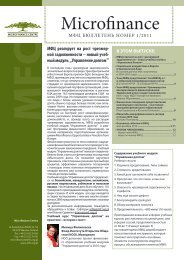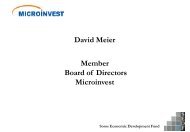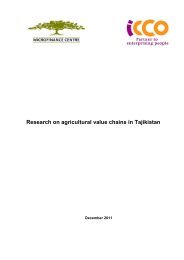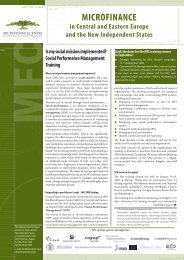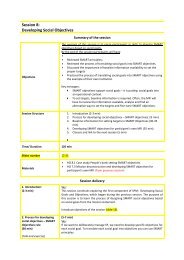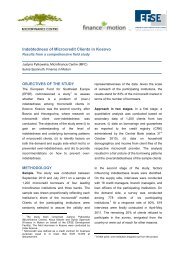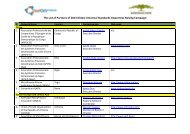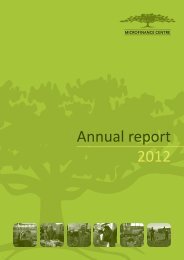In Central And Eastern Europe - Microfinance Centre
In Central And Eastern Europe - Microfinance Centre
In Central And Eastern Europe - Microfinance Centre
Create successful ePaper yourself
Turn your PDF publications into a flip-book with our unique Google optimized e-Paper software.
in <strong>Central</strong> and <strong>Eastern</strong> <strong>Europe</strong> and the New <strong>In</strong>dependent States<br />
21<br />
by international NGOs in Azerbaijan. Given the limited number of private credit-only MFIs, they are grouped<br />
and analyzed with NGO MFIs.<br />
Capital Structure<br />
NGO MFIs in the region are nonprofit organistions that have typically been capitalised by donor grants or<br />
concessional loans. However, most of them aim to become financially self-sufficient and earn a positive net<br />
income. Any profit is reinvested in their activities, rather than distributed to shareholders.<br />
The income-earning nature of microfinance has created legal ambiguity for NGO MFIs. The assumption that<br />
foundations and associations are supported, primarily or exclusively, by grants, individual donations, and other<br />
gratuitous transfers is built into the law of some countries in the region. <strong>In</strong> other countries, where the law is<br />
silent or ambiguous on the matter, public officials frequently interpret it to mean that earned income is restricted<br />
or prohibited.<br />
However, the importance of “earned income” for NGOs is growing. <strong>In</strong> fact, most countries surveyed now explicitly<br />
permit income-generating activities by both associations and foundations. <strong>In</strong> some cases, though, the NGO<br />
must establish a separate commercial, legal entity to house its income-generating activity, such as microfinance,<br />
particularly if the activity is unrelated to the NGO’s declared, socially beneficial purpose.<br />
Another potential source of capital for NGO MFIs is borrowing, whether on a concessional basis from donors<br />
or on a commercial basis from banks. <strong>In</strong> many countries in the region, the legal power for NGOs to borrow is<br />
not entirely clear, or there are ambiguities surrounding the permissibility of borrowing funds for on-lending (see<br />
Chapter 8 for further discussion).<br />
Because of their legal structure, NGO MFIs cannot accept commercial equity or take deposits. Hence, some<br />
have chosen to transform into another legal form, such as a private finance company or a bank, in order to<br />
expand their sources of capital. Examples include XAC in Mongolia, which transformed from an NGO to a<br />
finance company and then to a microfinance bank; Moznosti in Macedonia, and Microcredit Montenegro, both<br />
of which have transformed from NGO MFIs into banks with the help of Opportunity <strong>In</strong>ternational; and the<br />
Aga Khan programme in Tajikistan, which is planning to transform from an NGO operation into a bank.<br />
Clients<br />
About 60% of the 136 NGO MFIs surveyed reported that they target the economically active poor. The remaining<br />
NGO MFIs do not target the poor per se but typically lend to clients engaging in informal-sector activities,<br />
and registered microenterprises. These clients often fall in the lower-income segments of society.<br />
The NGO MFIs surveyed are more focused on reaching poor women than are other MFI types. <strong>In</strong> fact, only<br />
among the NGOs in the region are there organisations that target women exclusively. These include the<br />
members of the Russian Women’s <strong>Microfinance</strong> Network, and MI-BOSPO and Women for Women in Bosnia<br />
and Herzegovina. Because poor women typically suffer greater financial exclusion than men, microfinance has<br />
made them an important target group.<br />
Some NGO MFIs in post-conflict countries explicitly target war-affected groups, particularly displaced persons and<br />
returning refugees. One NGO MFI (VAAD in Romania) lends to nonprofit community enterprises (see Box 3.2).<br />
Organisational Models of <strong>Microfinance</strong> in CEE and NIS




